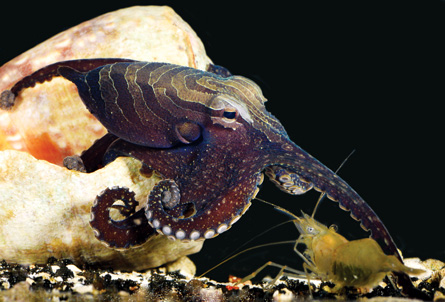of a schoolyard prank. And that’s not the only oddity about the species.
It’s only the second octopus known with females that prolong motherhood, instead of dying after weeks of
all-out coddling a single brood.
But what everyone wants to talk about, researchers who study the species
have found, is beak-to-beak mating.
Before writhing, wrestling videos of the larger Pacific striped octopus
(nicknamed LPSO), biologists knew of two forms of eight-armed sex.
Some species mate at a distance, says Roy Caldwell of the
University of California, Berkeley. The male extends one arm, always the same one,
toward the female and up under her mantle. A travel-ready package of sperm
emerges onto his skin and settles into a specialized groove on his mating arm.
Waves of arm flexing resembling mammal intestinal motions nudge the packet toward one of two
openings to her reproductive tracts.
“It’s a messy way of reproducing,” Caldwell says. A lot of sperm packets
“are wasted and go floating off.” Distance mating has other challenges.
In an Indonesian octopus species, Caldwell’s former student Christine Huffard of the Monterey Bay Aquarium
Research Institute discovered males hunkered in their dens sending an arm across
the seafloor into the den of the female next door. On occasion, such females leave
their dens on some octopus errand, dragging the male along by his mating arm.
In some small species, such as blue-ringed octopuses, a male positions himself
against a female’s mantle while reaching around and underneath with the mating arm.
But Caldwell, Huffard and colleagues report August 12 in PLOS ONE that LPSOs in the lab routinely coupled with
arms spread back, mouth to mouth.
“They actually line up their arms,” Caldwell says. He’s seen LPSO pairs matched eight to eight.
And it looks chancy. There’s grappling, and sometimes a female engulfs the male with
her arms and web — both moves that octopuses make when they fight. Afterward, males show marks left by female suckers.
LPSOs have subtler moves when offered a shrimp. Unlike other octopuses, the LPSO doesn’t just pounce.
Instead of pouncing, a larger Pacific striped octopus
reaches out to a shrimp for a sneak attack.

It eases out one arm slowly, slowly, and then just taps the shrimp on the shoulder.
The shrimp startles into flight — often directly into the octopus’s arms.